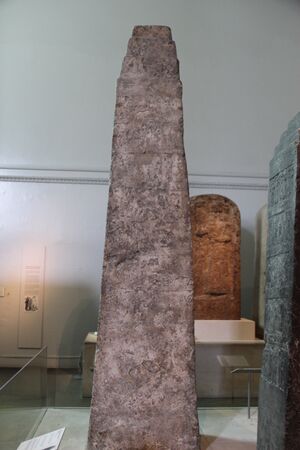آشور ناصر پال الأول
| آشور ناصر پال الأول Ashurnasirpal I | |
|---|---|
| ملك آشور | |
 The White Obelisk sometimes associated with Ashurnasirpal I (although it is usually dated to the reign of Ashurnasirpal II) | |
| King of the Middle Assyrian Empire | |
| العهد | 1050–1031 BC |
| سبقه | Shamshi-Adad IV |
| تبعه | Shalmaneser II |
| الأنجال | Shalmaneser II, Ashur-rabi II |
| الأب | Shamshi-Adad IV |
آشور ناصر أپلي الأول Aššur-nāṣir-apli I ، وتـُنقش maš-šur-PAB-A, “الإله أشور هو حامي الوريث”، كان ملك آشور، 1049–1031 ق.م.، and the 92nd to appear on the Assyrian Kinglist. He was the son and successor of Šamši-Adad IV, and he ruled for 19 years[i 1] during a troubled period of Assyrian history, marked by famine and war with nomads from the deserts to the west. He is best known for his penitential prayer to Ištar of Nineveh.
السيرة
According to a royal hymn composed in his honor, he was born “in the mountains that nobody knows,” suggesting he may have been born in exile, or perhaps a literary device, as it continues: “I was without understanding and I prayed not of your majesty.” It relates that, when Ištar appointed him to the kingship, he had restored her overthrown cult. Known from a single copy from the library of Ashurbanipal, it includes a plea to the goddess to restore him to health from the sickness that afflicted him, citing his temple-restoration, and devotions, to persuade her. It addresses Ištar of Nineveh, and Ištar of Arbil, as though they were separate deities.[1] A second, fragmentary literary prayer thanks her for her favor.[2]
A single short brick-inscription comes from his palace in Assur,[i 2] which was located between the south-west front of the ziggurat and the Anu-Adad temple. The White Obelisk[i 3] is sometimes attributed to him by historians, but more usually to his later namesake, Aššur-nāṣir-apli II, because its internal content (hunting, military campaigns, etc.) better matches what is known about his reign.[3] The Synchronistic Kinglist[i 4] gives his Babylonian counterpart as Kaššu-nādin-aḫi (c. 1006–1004 BC), but probably only for stylistic purposes as there seems to have been no recorded contact between the kingdoms during this period.[4]
He was succeeded by his son, Šalmanu-ašaredu II, who mentions him in one of his own inscriptions[i 5] and later by another son, the long-reigning Aššur-rabi II.
انظر أيضاً
النقوش
المراجع
- ^ W.G. Lambert. "Ištar of Nineveh". Iraq. 66: 35–39. doi:10.2307/4200555.
- ^ S. Fischer (1998). "Aššur-naṣir-apli I". In K. Radner (ed.). The Prosopography of the Neo-Assyrian Empire, Volume 1, Part I: A. The Neo-Assyrian Text Corpus Project. pp. 204–205.
- ^ D. J. Wiseman (1975). "XXXI: Assyria & Babylonia 1200–1000 BC". In I. E. S. Edwards; C. J. Gadd; N. G. L. Hammond; S. Solberger (eds.). The Cambridge Ancient History, Volume II, Part 2, History of the Middle East and the Aegean Region, 1380–1000 BC. Cambridge University Press. pp. 469–470.
- ^ J. A. Brinkman (1968). A Political History of Post Kassite Babylonia, 1158–722 BC. Pontificium Institutum Biblicum. p. 29.
للاستزادة
- Albert Kirk Grayson (1991). Assyrian Rulers of the Early First Millennium BC I (1114–859 BC). University of Toronto Press.
| سبقه Šamši-Adad IV |
King of Assyria 1050–1031 BC |
تبعه Šalmanu-ašaredu II |